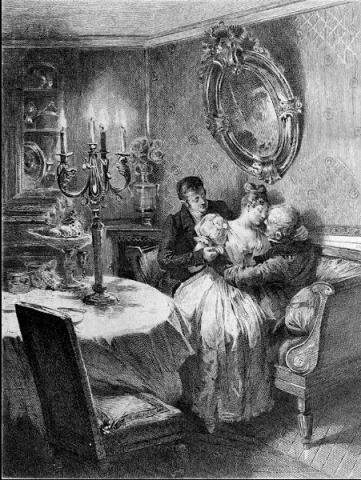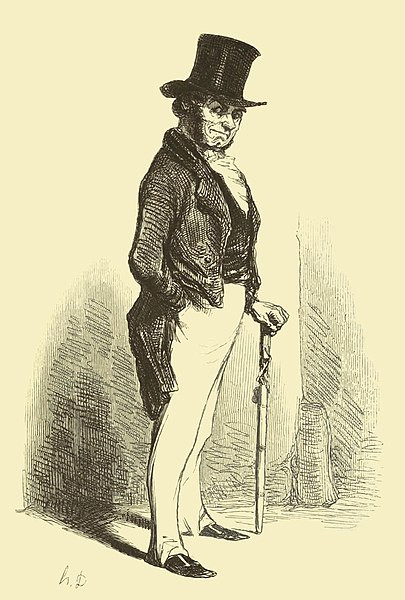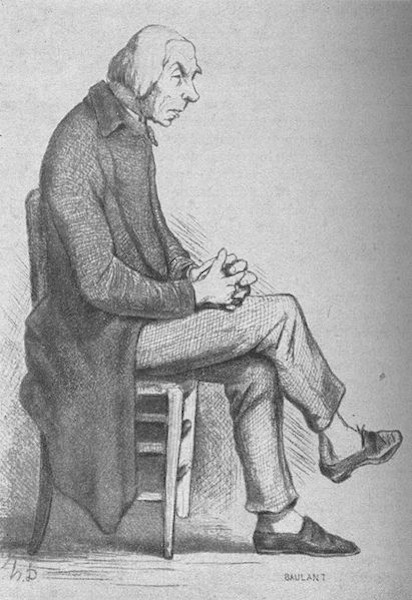Curating Identity: Fabric Façades in ‘Le Père Goriot’

“Clothing maketh the man.”—Shakespeare
Honoré de Balzac’s Le Père Goriot presents a montage of monetary drama and shady behavior. As crippling materialism infects many characters, the story unsurprisingly utilizes clothing as a mode of communicating wealth and curating one’s own identity. In fact, clothing seems to carry a hefty weight in expression of worth––or a lack thereof.
The gravity of clothing is apparent on multiple occasions: for example, when Madame Vauquer dates the wealthy Goriot for three months in order to buy clothes, or when Eugène de Rastignac “[learns] all he [needs] to know about the importance of tailors in a young man’s life.”
Subsequently, a lack of fine clothing is subject to harsh scrutiny and social deprecation. The only escape from this reality of clothing-induced judgment is the physical removal of clothing: the realist shedding of façade, rejection of any opportunity for societal analysis, and embrace of the natural self. Ultimately, in Père Goriot, Balzac presents fine clothing as a portal to social visibility and life completion in his storywide, realist critique of the superficial and over-valorization of wealth; the absence of clothing, then, allows for a realist portrait of true character and rebellion against expectations for self-presentation.
To first expand on the absence of fine clothing––as opposed to the absence of any clothing at all––Victorine Taillefer’s apparel that is “plain” and “obviously cheap” indicates the invisibility of her persona; because she is poorly clothed and not free of clothing, her true identity remains covered and overpowered by an undesirable presentation of self.
Upon introduction of Victorine, Balzac explains, “She was missing exactly those things––fine clothes and lovesick letters––that bring women to life for the second time.” First, since Balzac’s declaration that fine clothes may induce livelihood comes early in the story, it sets a precedent for the entire read and foreshadows future gravity in apparel choices. Next, because Victorine’s cheap clothing results from her father’s lack of support despite his wealth, a tie develops between rejection or neglect and apparel.

That element of deprivation is stained onto her cheap clothing. In addition, the female-centric component here––where fine clothes may bring women, specifically, to life––arises from a particular anti-feminism that results from the pressure for clothing to determine worth. From this feminist standpoint, clothing in general subjects Victorine to easy scrutiny, yet if she were to escape the consequences of clothing in its entirety and appear nude, that scrutiny would evolve into an escalated, sexualizing breed of shame. In essence, upon introduction, Victorine is trapped in cheap clothing, too neglected to present herself nicely and, as a woman, unequipped to liberate herself and abandon clothing altogether.
While Victorine’s femininity prevents her from experiencing a nude moment of escape, Vautrin’s criminal identity is uncovered through shirtlessness to convey that removal of clothing yields full truth. As Mademoiselle Michonneau and Poiret poison Vautrin and act on their quest to discover Vautrin’s brand on his shoulder, Mademoiselle Michonneau tells Poiret, “‘All right, hurry up and get his shirt off and right back on again! That way you can be good for something,’ she informed Poiret, ‘by keeping me from seeing him naked.’”
First, Mademoiselle Michonneau’s quickness––her desire to “get his shirt and right back on again”––is an instance of the characters’ general rejection of rawness and realism. Mademoiselle Michonneau rushes in order to minimize the discomfort of seeing somebody in the nude: without clothing to define them and their worth. Mademoiselle Michonneau even says that Poiret can “[keep her] from seeing him naked.” This wording is crystal clear, devoid of figurative language or even dramatic word choice and embellishment. Its simplicity suggests a genuine horror surrounding nudity and its realist consequences.
Mademoiselle Michonneau wishes to communicate her intention not to see Vautrin nude as clearly as possible. In addition, Mademoiselle Michonneau’s aggression and commands to Poiret emphasize her discomfort. Mademoiselle Michonneau wants confirmation of Vautrin’s criminal identity, but nothing more. Perhaps Vautrin’s poisoned, unconscious state also serves to limit the expression of truth that comes with removal of his clothing. To synthesize, Vautrin’s shirtlessness results in his secret’s release and confirmation, since his clothes, which allow him to design himself, vanish and he is left with only his true, inescapable flesh. Here, his naked exposure of his hidden, true identity encapsulates the link between nudity and realism.

Like Vautrin, Goriot has his moment of resulting truth. Goriot’s shirtlessness while motioning for his wrapped hair and locket in his moments before death embodies a vision of his true self, whose desire for accessories––clothing-esque items that are rebellious in their deviation from both luxury and typical articles of clothing that exist to impress––reflects his dying wish for love.
In preparation for his death, Bianchon states that Goriot’s sheets must be changed, and Goriot himself must also be changed into a better shirt. Bianchon says, “‘Let’s get his shirt off. You sit him up.’ Eugéne lifted the dying man, while Bianchon took off his shirt; the old man’s hands twitched, as if to protect something on his chest, making plaintive, incoherent sounds, like an animal trying to express immense pain.”
The twitching signals to Bianchon that Goriot wants the chain of Madame Goriot’s woven hair and the locket that is inscribed with his daughters’ names. The twitching conveys a chaotic lack of control and, therefore, an authentic and desperate desire for the hair and locket. In addition, the detail that both Eugéne and Bianchon must work together to remove Goriot’s shirt indicates that Goriot’s shirtlessness requires energy and preparation, since Goriot is so genuinely emotion-driven and his true self is ruled by feeling, even amid his daughters’ materialistic neglect. Further, as an immediate response to Goriot’s shirt coming off, Balzac articulates that Goriot tries to “protect something on his chest.” This immediacy verifies that Goriot’s thirst for protecting any ounce of love is a response to his nudity.
Goriot’s resemblance to “an animal trying to express immense pain” also emphasizes his distinction from humanity as it exists in Père Goriot, since Goriot is so alone in his internal separation from the superficial. Finally, the objects themselves––the woven hair and the locket––are fascinatingly clothing-esque in their wearability, but they are harshly distinct from clothing elsewhere in the novel, as they solely represent love and affection for Goriot. Woven hair in particular is far from socially impressive, and so these items rebel against the novel’s typical function for clothing: social climbing. In addition, because Goriot wants these items clasped onto his dying self, his emotional investment in the accessories is about himself and is not for show. The essence, then, of Goriot’s pre-death separation from his shirt is a correlation of his dying wish for eternal love with his last moment of nudity.

Victorine’s character prefaces Père Goriot with the criticism sparked by cheap, unimpressive clothing. Vautrin and Goriot––whose masculine nudity is only groundbreaking for its exposure of truth and not for its sexuality-based implications––exemplify the step into reality that results from the removal of clothing.
For both Vautrin and Goriot, their honest selves surface when their shirts disappear. In Vautrin’s case, this results in feelings of deep disturbance, and in Goriot’s, it precedes death. Goriot is destined for his life’s termination while in his truest form, and Vautrin, verifiably Death-Dodger, is representative of horror while in his.
Truth in Père Goriot seems to detach from its clothing façades and succeed societal suppression in moments of climactic doom. Reality not only lies beneath clothing––beneath appearance and subsequent labels––but it hides beneath it, creeping out with the mere removal of a shirt. Just as Gustave Courbet declares that “titles have never given a true idea of things,” clothing in Père Goriot titles its characters in preservation of a society that revolves around the superficial and rejects realism.
Author Bio:
Eva Berezovsky, a Highbrow Magazine contributor, is an honors student at the University of Minnesota in Minneapolis. Earning her B.A. in Cultural Studies & Comparative Literature, Eva’s academic life roots itself in analysis of literature, film, art, and design. With professional experience in both museum/gallery spaces and editorial ones, Eva is fueled by bringing theoretical and analytical thinking to vessels of cultural portraiture and storytelling. Her creative portfolio can be accessed at evaberezovsky.com.
For Highbrow Magazine
Image Sources:
--Wikipedia (Creative Commons)
--Cdrummbks (Flickr, Creative Commons)
--Honore Daumier (Wikimedia, Creative Commons)
--Honore Daumier (Wikimedia, Creative Commons)































































































































































































































































































































